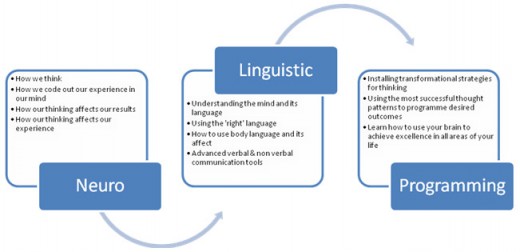Neuro-Linguistic Programming (NLP) as a tool to model successful pupils’ behaviour

Learn more about NLP
- NLP Secret
You can learn more about NPL in the above site
NLP links
- Start Your Own Cookie Business
Do you enjoy baking? Would you like the freedom of working from home or working for yourself in a small bakery of your own? If so, you might want to start your own cookie business. You can start as a... - Bake a Yule Log Cake!
Get recipes and frosting tips for baking a Yule Log Cake! Recipe variations (including gluten-free!), lots of great pictures and how-to frosting tips for decorating this fun holiday dessert. - The Best Salmon Recipes
Salmon is a delicious and healthy fish. Learn some really easy ways to cook salmon and check out the best salmon recipes! - Seattle's Pike Place Market
Seattle's 100-year-old Pike Place Market is open daily, with fresh produce, local craftspeople and so much more! This waterfront locale is a popular destination for locals and visitors. It's near the Ferry Terminals, is easily reachable by public tra - Get the job of your dreams: Post-interview Follow-up
P. Inglish 2005 After you have done all the hard work of preparing a resume and cover letter, applying for a job, researching the company thoroughly and then completing a fantastically good interview,...
Neuro-Linguistic Programming (NLP) as a strategic tool to modelling success in pupils’ behaviour
By Benjamin S C Ugoji
Introduction
Pupils’ behaviour in schools can affect their performance in terms of their outcome or achievement at school work. Schools experience different behavioural difficulties due to pupils not adhering to whole school policy on behaviour. The problem is that a lot of time is wasted because teachers, other students and behaviour workers in school are involved in the process of addressing these behavioural issues. Schools have different strategies in place to plan, monitor and evaluate pupils’ behaviour. The question is how effective are these strategies? A technique for managing behaviour is as effective as the problem is able to solve. What outcomes do schools want to achieve in terms of pupils’ that are misbehaving? For example, most pupils enjoy being sent out of the classroom during lessons. Is there a t strategy to permanent change their behaviour so that they can be more effective?
The purpose of this article is to suggest ways NLP could be used to model pupils’ behaviour through changing their old habit and inputting a better one. NLP will be described and strategies to use it to model behaviour will be discussed. The implications of such tool will be highlighted.
NLP a brief outline
Neuro-Linguistic Programming (NLP) is the study of how we think and experience our world around us. Obviously, the nature of our brains and consciousness has not become an exact science quite yet, so the main method used by NLP is to form models of how these things work.
NLP is about identifying patterns in your thinking, beliefs, and behavior, and learning how to consciously choose which patterns to keep and which ones to change.
In neuro-linguistic programming, “neuro” refers to the neural pathways in our brain that send, receive, and store the chemical signals that make up the information that is in our heads.
The “linguistic” part is the actual content of that information that moves along those neural pathways. Even though the word “linguistic” refers to verbal information, non-verbal information is also included here.
And the programming is the ways in which these chemical signals are manipulated to become information that makes sense to us and that we can use.
NLP (Neuro-linguistic Programming) first emerged under that name in the early ‘70s in the U.S. as a way of examining the thinking and behavioral processes of extremely productive and successful people.
The two people generally credited with developing NLP are Richard Bandler and John Grinder. Bandler was a psychology student at the University of California at Santa Cruz in 1970, when he joined a group led by Grinder, then an associate professor of linguistics at the school.
The two men became friends and began working together, both influenced by the Family Therapy work of Virginia Satir, Fritz Perls’ Gestalt Therapy, and Milton H. Erickson’s work. Bandler used his background in mathematics and computers and Grinder used his linguistics knowledge to detect patterns and create models. The models are then used to create techniques for quickly changing thoughts, beliefs, and behaviors that you may not want or need anymore, or even be aware of. 1
Unconscious and conscious awareness: internal and external manifestations of behaviors
If you plant a grain of corn, you will reap harvest of corns. This will however depend on the seed, the environment and the care given to the plant prior to harvest. But how often do we want to reap rice where we have planted a seed of corn. Well this picture is for you to see that if you want to change behavior we need to sow the seed of thought in our mind that will produce the outcome that we want. You are responsible for the thought that goes in your mind, the pictures you paint and the behaviors that comes out as a result. Your internal environment which is made of your belief, value, and identity determines the outcome of your behaviour.
John Maxwell in his book ‘Thinking for a change’ has this to say on thinking:
“If you change your thinking, you change you belief,
Changing your believe changes your expectation,
When your expectation is changed your attitude changes,
Changes attitude will lead to changed behaviour,
Changed behaviour changes your performance
And changing your performance changes your life.”2
It is very important for us to understand the thinking habits and belief people hold about their behaviour; since, shared assumptions and beliefs interact with shared values and produce shared norms that drive the pattern of behaviour.
Neurological levels of thinking
This framework for thinking at neurological level could be likened to the Bloom’s taxonomy for cognitive development in planning instruction.
Logical level of change is a model devised by Robert Dilts a Neuro Linguistic programming Expert, based on the ‘neurological levels’ proposed by anthropologist Gregory Bateson.
Identity
Belief and values
Capabilities
Behaviour
Enviroment
System
Figure 1 Logical levels of thinking3
Logical levels of thinking can help you to solve problem, uncover hidden information and gather extra insights about a situation from different viewpoints and build up a ‘big picture view’ view of events. Therefore it is a tool to analyse, apply, synthesis, and evaluate the way we think. The Neurological level of thinking for learning and change can enable us to effect change at the mental, physical and physiological and psychological levels.
How to use the Neurological levels of thinking as a tool to model behaviour
In describing the strategies to model behaviour of students’ using the Neurological levels of thinking as a tool; it will good to set the ground rules in applying this strategy.
The objective is to enable pupil to become effective in their performance as a result of change in their behaviour.
Hence, this section will be made up of the following sections:
The principle
The paradigm shift
The process
The outcome
The principle: The students should be meant to understand that they are 100% responsible for their behavior and that they have the choice to change their outcome.
In his book, ‘How to get from where you are to where you want to be’, Jack Canfield, shared his thought on an important formula he learnt from Dr Robert Resnick, a psychotherapist in Los Angeles. The formula is:4
E + R = O
(Event + Response = Outcome)
If you want to change the outcome you need to change the response.
The paradigm shift
The behaviours we exhibit are due to the unconscious maps we have – beliefs, values and identity. If we change these invisibles and replace them will effective ones that will favour our environment we become more effective.
The process
This is the journey to effect change. Change is not easy and it has to be one small step at a time. The idea hear is that the internal and external attributes to install the behavior we require will be aligned at all the levels in the neurological levels of thinking framework. The five levels of change are illustrated below:
Environment: Where? And When?
Where and when does this behaviour occur? Is it a palace, at work, at home, with colleagues? What is the setting and context when the problem arises?
Behaviour: What is happening?
What is being done, by whom, to whom? Equally what is not being done depicts inactivity. Behaviour is what you actually do
Capability: How is this being done?
Capability is about how someone does something, or how confident they feel to do it. Having capability is what makes people feel confident and in control of situations. Lack of confidence towards a particular task may be due to lack of capability on part of the performer.
Beliefs and values: Why?
These attributes motivates us to take action. Our beliefs and values are personal to us, and what we believe is or is not possible to us.
Identity: Who?
Who do you think you are/ This is your identity, who you think you are? All your actions derive from your sense of who you are.
Part of the system:
Who else or what else affect the behaviour?
(Adapted from Robert Dilts (and others),
TheNeurological levels of thinking)5
The outcome
The idea is for pupil to be able to manage their behaviour through becoming effective in the use of the Neurological levels of thinking.
They have to change their internal drivers of behaviour (belief, value and identity) to match the pattern of behaviours required in a given environment. When they change the pictures in their mind due to changed thinking it impact their emotions positively to achieve the outcome that they desire.
Conclusions
An efficient program should be able to adapt to the problems introduces by the environment or other parts of the system.TheNeurological levels of thinking have been used in different fields to model competence and excellence.5 It could be a very versatile and robust strategy to model and improve pupils’ behaviour in schools.
References
- Ken Strong (2006). NLP in Business and in life - (e-book). White Dove Books.
- John C Maxwell (2003). Thinking for a change. 11 Ways highly successful people approach life and work. Warner Business Books
- Frances Coombes (2008) Self-Motivation . Hodder Education.
- Jack Canfield (2007). How to get from where you are to where you want to be: The 25 principles of success. Harper Collins Ltd. London.
- Robert B. Dilts and Gino Bonissone (1993). Skills for the Future: Managing creativity and innovation. Meta publications California.
© 2009 Benjamin S C Ugoji http://www.hubpages.com/profile/lemmyc









